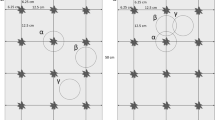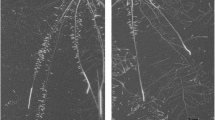Abstract
The concentration of apoplastic Fe in roots of soil-grown plants was determined in order to evaluate the possible significance of the root apoplast as storage pool for Fe. Roots were grown in membrane bags maintaining contact with the soil solution but without direct contact with the soil. It could be shown that the concentration of apoplastic Fe in roots grown in most soils was lower than 50 mg kg-1 root dry matter. This concentration is much lower than previously reported from nutrient solution and soil-grown cultures (about 1000 mg kg-1 dry matter). The concentration of apoplastic Fe in strategy I and strategy II plants was little affected by the different soils used. Direct contact of roots with soil led to soil contamination at the root surface and so to an overestimation of the apoplastic Fe pool. Soil contamination of roots grown in direct contact with soil was detected by measuring the soil markers Ti, Si and Al and was further shown by PIXE. In conclusion, the low concentration of apoplastic Fe in roots demonstrates that the root apoplast is less significant as storage pool for Fe than previously assumed.
Similar content being viewed by others
References
Awad F, Römheld V and Marschner H 1995 Effect of root exudates on mobilization in the rhizosphere and uptake of iron by wheat plants. Plant and Soil 165, 213–218.
Bienfait H F, Van den Briel W and Mesland-Mul N T 1985 Free space iron pools in roots: generation and mobilization. Plant Physiol. 78, 596–600.
Brown D A and Noggle J C 1955 Ion exchange in soil-plant root environment. I. Measurement of suites of cations at various stages of nutrient uptake. Soil Sci. Soc. Proc. 19, 131–134.
Brown J C and Ambler J E 1974 Iron-stress response in tomato (Lycopersicon esculentum) I. Sites of Fe reduction, absorption and transport. Physiol. Plant. 31, 221–224.
Campbell R and Rovira A D 1973 The study of the rhizosphere by scanning electron microscopy. Soil Biol. Biochem. 5, 747–752.
Cary E E, Grunes D L, Bohman V R and Sanchirico C A 1986 Titanum determination for correction of plant sample contamination by soil. Agron. J. 78, 933–936.
Cline R C, Powell P E, Szaniszlo P J and Reid C P P 1982 Comparison of the abilities of hydroxamic, synthetic, and other natural organic acids to chelate iron and other ions in nutrient solution. Soil Sci. Soc. Am. J. 46, 1158–1164.
Foster R C 1981 The ultrastructure and histochemistry of the rhizosphere. New Phytol. 89, 263–273.
Lindsay W L and Schwab A P 1982 The chemistry of iron in soils and its availability to plants. J. Plant Nutr. 5, 821–840.
Lindsay W L and Norvell W A 1978 Development of a DTPA soil test for zinc, iron, manganese, and copper. Soil Sci. Soc. Am. J. 42, 421–428.
Longnecker N and Welch R M 1990 Accumulation of apoplastic iron in plant roots. Plant Physiol. 92, 17–22.
Mengel K 1994 Iron availability in plant tissues - iron chlorosis on calcareous soils. Plant and Soil 165, 275–283.
Mitchell R C 1960 Contamination problems in soil and plant analysis. J. Sci. Food Agric. 11, 553–560.
Norvell W A and Cary E E 1992 Potential errors caused by roots in analyses of rhizosphere soil. Plant and Soil 143, 223–231.
Römheld V and Marschner H 1986 Mobilization of iron in the rhizoshere of different plant species. In Advances in plant nutrition. Ed. B Tinker and A. Läuchli. pp 155–204 Vol. 2. Praeger Publishers, New York.
Von Wirén N, Mori S, Marschner H and Römheld V 1994 Iron inefficiency in maize ys1 (Zea mays L. cv. yellow-stripe) is caused by a defect in uptake of iron phytosiderophores. Plant Physiol. 106, 71–77.
VonWirén N, Römheld V, Shioiri T, Marschner H 1995 Competition between micro-organisms and root of barley and sorghum for iron accumulated in the root apoplasm. New Phytol. 130: 511–521
Yehuda Z, Shenker M, Römheld V, Marschner H, Hadar Y and Chen Y 1996 The role of ligand exchange in the uptake of iron from microbial siderophores by graminceous plants. Plant Physiol. 112, 1273–1280.
Zhang F S, Römheld V and Marschner H 1991a Diurnal rhythm of release of phytosiderophores and uptake rate of zinc in irondeficient wheat. Soil Sci. Plant Nutr. 37, 671–678.
Zhang F S, Römheld V and Marschner H 1991b Role of the root apoplasm for iron acquisition by wheat plants. Plant Physiol. 97, 1302–1305.
Author information
Authors and Affiliations
Rights and permissions
About this article
Cite this article
Strasser, O., Köhl, K. & Römheld, V. Overestimation of apoplastic Fe in roots of soil grown plants. Plant and Soil 210, 179–189 (1999). https://doi.org/10.1023/A:1004650506592
Issue Date:
DOI: https://doi.org/10.1023/A:1004650506592




